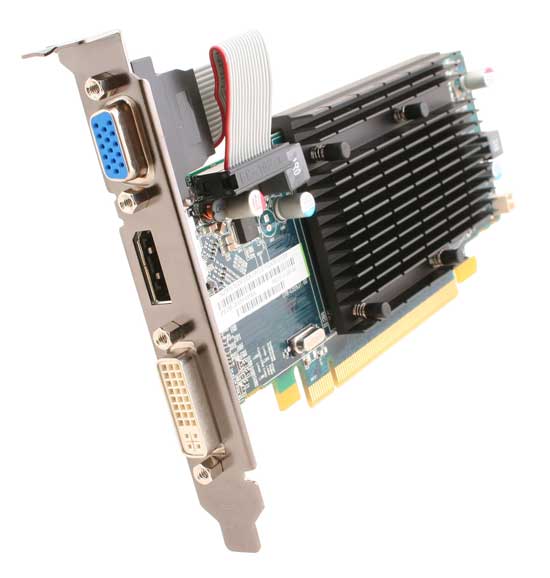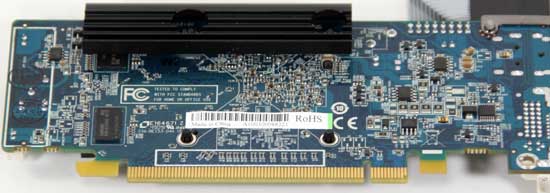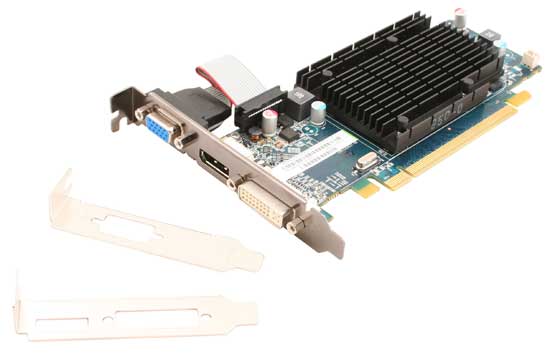AMD’s Radeon HD 5450: The Next Step In HTPC Video Cards
by Ryan Smith on February 4, 2010 12:00 AM EST- Posted in
- GPUs
Meet the Sapphire 5450
Along with our reference card from AMD, Sapphire also sent in their near-reference 5450. As it was clocked correctly at 650MHz/800MHz, we were able to use this card to benchmark the 5450 at its proper clocks, so we’d like to thank Sapphire for sending this in.

The Sapphire 5450 is nearly identical to AMD’s reference card. It uses the same PCB and the same port configuration, and the RAM chips are the appropriate 800MHz Samsung DDR3 chips. The key difference between the two cards is that while AMD is using a double-wide heatsink, the Sapphire 5450 is using a smaller single-wide heatsink. This means that the Sapphire 5450 will fit in to cases where only a single slot’s worth of space is available below the card.

However on the flip side (in all senses of the word) Sapphire’s heatsink wraps around the card slightly, which results in it sticking up from the back side of the card. Technically speaking the heatsink is encroaching on the space that belongs to the card above it, so the Sapphire card won’t fit if there’s a card more than 2 inches long in the slot above it, or if there are tall motherboard components there. In our case it encroached on the audio riser card for our Rampage II Extreme Motherboard. This shouldn’t be a problem for the vast majority of users and is more compatible than a card with a double-wide heatsink, but nevertheless check your case to make sure there’s room for the heatsink on the back side of the card.

As is usually the case with bottom-tier cards, Sapphire packs the 5450 with very little. It comes with a driver CD, the low-profile brackets for the card (it ships with the full-profile bracket installed), an instruction manual, and ArcSoft’s SimHD plugin for upconverting video conferencing feeds. Surprisingly, all of this comes in a full-sized box – this is the first sub-$100 card we’ve seen in some time to not come in a mini-box.
Sapphire also sent along their entire 5450 product chart. Of note, they will be releasing DDR2 and DDR3 cards with HDMI ports that are otherwise identical to today's DisplayPort card, so HTPC users will not be left out in the cold.










77 Comments
View All Comments
Taft12 - Thursday, February 4, 2010 - link
Replying to my own post to say I reread the 5670 article and indeed the 5500 series is mentioned there and I am VERY sure this is what Ryan was referring to earlier when he said "wait a week"juampavalverde - Thursday, February 4, 2010 - link
I dont see the improvement over the past generation 4550. DX11 is useless in such slow cards (is almost useless for a 5670!). I expect this level of performance from a next gen IGP, not a discrete chip. AMD should have raised high the performance bar for this generation, releasing something like 5450 (120 sp), 5670 (640 sp, like 4770), 5770 (960 sp), and 80 sp for the IGP.Taft12 - Thursday, February 4, 2010 - link
The improvement is purely in power consumption. They can't improve performance of these lowest-end discrete cards or IGPs too much or they will eat into the value of the next step up (4670, 5670). You may "expect this level of performance" but you aren't gonna get it.Rick83 - Thursday, February 4, 2010 - link
I'd be rather interested in seeing a differentail analysis of power consumption of the two ATI cards (5450/5670) at rendering a h264 encoded 1080p movie with dts out via the card, as well as blu-ray with "HD".And a video benchmark, to show how much bitrate/fps the respective cards manage, before desync/framedrop/freeze.
Power during furmark (or gaming) is of course higher on the 5670, because it has five times as many shaders to feed - depending on how smart ATI's power management is, the two cards might not differ a lot, if used in an HTPC.
And frankly, the 50 dollars extra would be probably worth the extra rendering/decoding horsepower, especially in an HTPC, where you want buttery smooth performance, and not worry about bitrate.
Oh - any news on passive 5670's? If they can do 5750's, I'm sure there'll be a few 5670's someday?
Ryan Smith - Thursday, February 4, 2010 - link
This isn't something we tested since it really isn't an issue. The Cheese Slices test peaks at 35MBps MPEG-2, and I have an H.264 version that peaks at a similar bitrate.The 5450 has enough power for anything up to 1080p Blu-Ray.
Rick83 - Thursday, February 4, 2010 - link
Well, considering the extra shader load added by filters, apparently it may not be - or the proper algorithm for deinterlacing would have been available.And that also leaves the question of the power draw of a 5670 at 5450 levels of performance - I'm pretty sure that in an HTPC, unless you use it as a console replacement for gaming, there will ever be a situation where the gpu is fully loaded, hence power input should be lower than the full-tilt number you published.
dagamer34 - Thursday, February 4, 2010 - link
Most HTPCs are meant to be small, and there's no way you're going to be able to fit a 5700 series card into a low-profile space. I know they had 4650s last generation, but there aren't any 5650s yet. =/Redstorm - Thursday, February 4, 2010 - link
I just cant see how reviewers are claiming this card is the perfect HTPC video card. Not everyone uses Microsofts Media Centre. Lack of VDPAU support for Linux is a glaring hole in all ATI cards, If I were building a gameing PC today I would probably buy an ATI 5870, But if your building a low power HTPC you cant go past nVidia and VDPAU support. Take their ION platform will do 1080p in hardware on Linux for less than 30Watts this beats this ATI offering hands down when you add in Motherboard and CPU.Best HTPC card I think not...
CiNcH - Thursday, February 4, 2010 - link
XvBA is also said to be working, which also acts as a backend to VA-API, just like VDPAU. They are even examinig the legal situation and whether the UVD specs can be opened to be support within the OSS (xf86-video-ati) driver. Of course nothing that will be done by tomorrow.What I think would be worth mentioning, when it comes to HTPC comparing nVIDIA and ATi, is that UVD won't play H.264 higher than level 4.1. nVIDIA's PureVideo is capable of decoding up to level 5.1.
milli - Thursday, February 4, 2010 - link
The Evergreen series does apply angle independent anisotropic filtering. Also the fixed function interpolators have been removed and moved to the shaders.Considering the limited power of the HD 5450, this causes a bigger performance drop compared to the other Evergreen products.